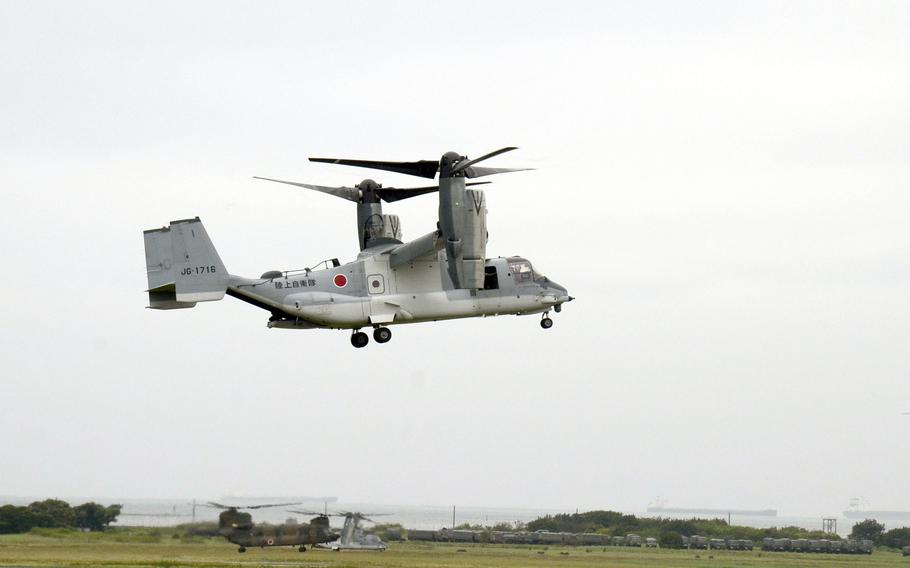Asia-Pacific
Japan grounds its Osprey fleet after tiltrotor mishap during Keen Sword drill
Stars and Stripes October 28, 2024

A Japanese V-22 Osprey operates at Camp Kisarazu in Chiba prefecture, Japan, Oct. 5, 2024. (Japan Ground Self-Defense Force)
CAMP FOSTER, Okinawa — Japan grounded its Osprey fleet over the weekend after one of the tiltrotor aircraft hit the ground during a joint exercise with U.S. forces, according to Japan’s Joint Staff.
The V-22 assigned to the 1st Helicopter Brigade of the Japan Ground Self-Defense Force was transporting a military member acting as a patient during a disaster response drill Sunday morning, a spokesman for the Joint Staff said by phone Monday.
None of the 16 troops on board were injured in the incident, and the only damage was to the aircraft, the spokesman said. He declined to say if U.S. personnel were on board.
The drill was part of Keen Sword, a U.S.-Japan military exercise taking place throughout Japan until Friday, a Joint Staff news release said Sunday.
The Osprey was attempting to take off from Camp Yonaguni, a Japanese base on a remote island, when it became unbalanced and began “shaking left to right” at 11:38 a.m., the release said. The bottom of the left wing “made contact with the ground,” damaging part of the aircraft.
The Osprey took off and landed in a field inside the camp, he said without providing a further description of the damage.
U.S. Forces Japan acknowledged questions emailed by Stars and Stripes on Monday but did not immediately provide responses.
U.S. and Japanese pilots were slated to fly Ospreys for the first time to Yonaguni Island southwest of Okinawa, the Japanese island closest to Taiwan, during this year’s Keen Sword, the Joint Staff announced in September.
This is the first time a Japanese Osprey was damaged “by hitting the ground,” the spokesman said. He did not say if Ospreys had been damaged in any other way before.
The Self-Defense Force will ground its fleet of 17 Ospreys pending an investigation and “until the reason becomes clear, and the measures are transmitted to the troops,” the spokesman said.
“I really want to apologize for causing this situation and causing worries to the related communities,” 1st Helicopter Brigade commander Maj. Gen. Toshihiko Hirose said in a statement relayed by the Joint Staff spokesman. “We will keep working hard to fly safely.”
Keen Sword is a biennial exercise that began in 1986 to increase combat readiness and improve the working relationship between U.S. and Japanese forces.
This year’s exercise is expected to include 12,000 U.S. and 33,000 Japanese troops, 40 vessels and 370 aircraft, according to a Joint Staff news release Sept. 26. It includes 900 Marines and sailors from across the III Marine Expeditionary Force, according to a news release Oct. 1.
Okinawan officials, including Gov. Denny Tamaki protested the Osprey flights before the exercise.
“As the prefecture we want them to clarify the reasons of this incident and again, we want to ask them to refrain from flying the Ospreys for this exercise,” a spokeswoman for Okinawa’s Military Base Affairs Division said by phone Monday.
Some Japanese government officials are required to speak to the media only on condition of anonymity.
This incident involving a Japanese Osprey occurred just as U.S. Ospreys are resuming something close to a normal flight regime. This month, Air Force Ospreys flew from Yokota Air Base in western Tokyo to Okinawa for the first time since a fatal accident in Japan last year.
U.S. and Japanese Ospreys were grounded between December and March following the Nov. 29 crash of a Special Operations Command tiltrotor just off Yakushima, an island south of Kyushu in southern Japan. The Marine Corps has Ospreys stationed at Marine Corps Air Station Futenma on Okinawa.
All eight crew members aboard the Osprey were killed. The accident investigation found a catastrophic mechanical failure at fault, compounded by a “lack of urgency” by the crew at the time, according to the accident report.
The revolutionary aircraft lands and takes off like a helicopter but flies as a fixed-wing aircraft.